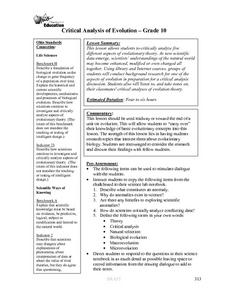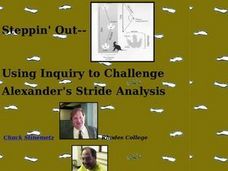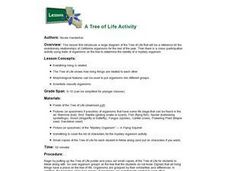Curated OER
The Ultimate Predator
Students already know that the most effective predator on earth today. They pay close attention, because after the teacher have finished lecturing, their assignment is to design a new "Ultimate Predator." Students present their...
Curated OER
The Opposable Thumb
Learners participate in an activity which helps them realize the importance of the opposable thumb through trying to live without it. The goal of this activity is for students to understand the physical importance of the opposable thumb.
Curated OER
Genetic Jewels: Building the DNA Model
Students construct segments of DNA to create a piece of jewelry. In this genetics lesson students create a DNA sequence that they turn into something to wear.
Curated OER
What did T. rex taste like?
Students examine the three domains of life and explain that all living things share a common ancestor. In this paleontology lesson students are introduced to the process of illustrating evolutionary relationships.
Curated OER
Battle of the Beaks
Students explore adaptive advantage, based on beak function, by simulating birds competing for various foods.
Curated OER
Anthropology and Sociology
Students examine the combined subjects of anthropology and sociology and explain how the disciplines would study the same issue. On poster board, they locate or draw pictures related to the two subjects. Once this is completed, students...
Curated OER
Comparative Embryology
Students compare and contrast the embryonic development of human, chicken and fish embryos. They create a detailed outline of similarities and differences among the three embryos at various stages of development.
Curated OER
Using A Winogradsky Column to Analyze Microbial Communities
Students use easily obtained materials to study ecological succession in a microbiological community. This investigation is appropriate for a variety of age groups. Elementary Students be fascinated by the changes occurring over time...
Curated OER
Understanding the Geologic Timescale
Learners identify and analyze how the geologic time scale was developed by investigating 11 periods of time and the vast expanse of time of the Earth's existence. They study their period, determine the important factors indicative to...
Curated OER
The Process of Speciation
Students illustrate the results of natural selection by identifying conditions that could lead to the development of new species (speciation) based on a given description of environmental conditions and description of variation within a...
Curated OER
The Short Answer
Students examine the discovery of the Flores man. In this anthropology lesson plan, students discover details about the Flores man and the work of anthropologists. Students are challenged to create their own stories that explain Flores man.
Curated OER
Create Your Own Animal
Students design and create their own hypothetical animal. For this biology lesson, students identify the factors organisms need to survive. They classify their animals according to its correct phylum.
Curated OER
Critical Analysis of Evolution
Tenth graders discuss anomalies in nature and science. They discuss times that anomalies led to the collection of data that explained the phenomena and contributed to changing scientific understandings. Students work in groups to...
Curated OER
Studying Species by Examining the Evolution of the Canidae Family
Pupils examine the definition of species. Students complete a phylogentic tree of the Canidae family. They write an essay justifying why or why not wolves and dogs should be classified as different species.
Curated OER
How the Light Bulb Gets Switched On - The Evolution of Ideas
Students discuss how people are influenced by their cultures and backgrounds, make artwork that documents creative process, write character sketch of Colonel Massey from different points of view, examine issue from different perspectives...
Curated OER
Fossils And Migration Patterns in Early Hominids
Students plot the general distribution of major fossil hominid taxa on a small black and white world map using data provided. They infer a continent of origin and likely path of migration using a worksheet guide and small group discussion.
Curated OER
Steppin' Out: Using Inquiry to Challente Alexander's Stride Analysis
Students distinguish between walking, jogging and running trackways in humans. They analyze the phylogenetic progression of the leg position as described by pace width and angulation, comparing amphibians, reptiles and mammals. Research...
Curated OER
A Tree of Life Activity
Students solve a mystery of the identification of a unknown organism by comparing its morphological characteristics to those in a tree of life classification poster. They compare the observable characteristics of the specimen and...
Curated OER
What about Continental Drift?
Fifth graders research the Continental Drift by researching for evidence of continental movement. The teaching explains the theory of plate tectonics and the Earth's magnetic field. They conclude the lesson by watching the video of "In...
Curated OER
How Do Species Change?
In this species changing worksheet, students will brainstorm problems that species face in their habitats. Then students will write in the solution for each problem they wrote down in this graphic organizer worksheet.
Curated OER
What Do Fossils Reveal?
In this fossils worksheet, students will write down 4 facts that they know about fossils and then come up with 1 conclusion about fossils based on their facts. This worksheet is a graphic organizer.
Curated OER
The Earliest Primates
In this early primate worksheet, students will read information about the fossil evidence of the earliest primates. Students will complete 3 short answer questions based on their reading.
Curated OER
Do-It-Yourself Fossils
In this fossils activity, students create their own casts, molds, imprints, and embedded fossils. Then students complete a fossil comparison chart. This activity has 12 fill in the blank questions.
Curated OER
Sponges, Cnidarians, Flatworms, and Roundworms
In this simple animals worksheet, high schoolers compare and contrast the body plans of sponges, cnidarians, flatworms, and roundworms. This worksheet has 4 short answer questions.
Other popular searches
- Human Evolution
- Evolution Worksheet
- Theory of Evolution
- Evolution of Transportation
- Fossils and Evolution
- Adaptation and Evolution
- Evidence of Evolution
- Evidence for Evolution
- Evolution Charles Darwin
- Dog Evolution
- Biological Evolution
- Evolutionary Theorists

























